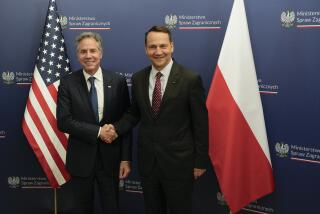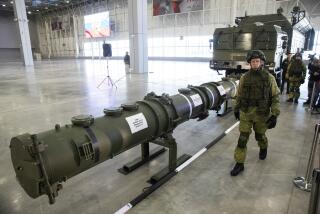Time to Negotiate
Washington officials have been saying for months that the best hope for an arms-control breakthrough lay in cutting nuclear missile forces in Europe. Soviet proposals to freeze and then start dismantling missiles on both sides, they said, looked promising. The trouble was that it was all talk and American negotiators in Geneva had nothing in writing.
That changed abruptly last week. A formal Soviet proposal was delivered to U.S. negotiators, following through on phase one in an arms-control plan outlined by Soviet General Secretary Mikhail S. Gorbachev in a speech last January.
That means that at least one of the three rings of the Geneva arms-control circus can come to life. It also means that for the first time since the famous 1982 “walk in the woods,” the United States and the Soviet Union may have to face up to the question of how serious they are about arms control generally. Both flunked the test then, rejecting a proposal worked out in quiet meetings in Geneva’s Botanical Gardens and agreed to in a final meeting in a mountain forest between U.S. negotiator Paul Nitze and Soviet negotiator Yuli Kvitsinsky. Neither nation has come close to agreeing on anything since then.
The Soviet plan covers only relatively short-range missiles, their own SS-20s pointed at Europe and American Pershing II missiles, pointed at the Soviet Union.
Washington officials said last week the plan needs work. It covers medium-range missiles in Europe but not in Asia. It would mean stopping French and British plans to put multiple warheads on their own missile forces, something that both countries oppose.
It has one good point. The proposal does not link discussions of European missiles to agreement on Star Wars, as do Soviet proposals on intercontinental missiles and weapons in space, so that U.S. insistence on going ahead pouring billions of dollars into its pipe dream of a nuclear shield over the United States would not slow down bargaining on medium-range missiles.
So it is an outline, a place to begin to rein in the nuclear arms race. And working with outlines and exchanging ideas on how to deal with disagreements is what negotiators are for and why both countries write paychecks every month for their bargaining teams and put them up in comfortable quarters.
As we said, what happens with the outline is also a test of both countries, a test of whether arms control can be a true walk in the woods or whether what is going on in Geneva is a walk in the wilderness.
More to Read
Sign up for Essential California
The most important California stories and recommendations in your inbox every morning.
You may occasionally receive promotional content from the Los Angeles Times.










